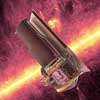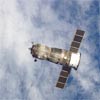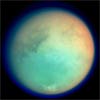|
News Archive: May 1-31 |

|
Shuttle Atlantis passes flight readiness review
NASA managers Thursday wrapped up a two-day flight readiness review and cleared the shuttle Atlantis and its seven-member crew for blastoff June 8, at 7:38 p.m., on a hail-delayed mission to deliver a new set of solar arrays to the international space station.
 FULL STORY FULL STORY
 NASA TELEVISION SCHEDULE NASA TELEVISION SCHEDULE
 STS-117 MISSION COVERAGE STS-117 MISSION COVERAGE
 |  |

|
 |

Additional coverage for subscribers:
 VIDEO:
NEWS BRIEFING FOLLOWING THE READINESS REVIEW PLAY VIDEO:
NEWS BRIEFING FOLLOWING THE READINESS REVIEW PLAY
 MORE:
STS-117 VIDEO COVERAGE MORE:
STS-117 VIDEO COVERAGE
 SUBSCRIBE NOW SUBSCRIBE NOW

|
100th Long March rocket
soars with TV satellite
A television broadcasting satellite to cover Southeast Asia was launched Thursday on the 100th flight of China's venerable Long March rocket family, state media reported.
 FULL STORY FULL STORY
 |  |

|
 |
Space telescope gives scientists depth perception
Astronomers now have a new "eye" for determining the distance to certain mysterious bodies in and around our Milky Way galaxy. By taking advantage of the unique position of NASA's Spitzer's Space Telescope millions of miles from Earth, and a depth-perceiving trick called parallax, they were able to pin down the most probable location of one such object.
 FULL STORY FULL STORY
 |  |

|
 |
Galaxy cluster takes it to the extreme, Chandra finds
Evidence for an awesome upheaval in a massive galaxy cluster was discovered in an image made by NASA's Chandra X-ray Observatory. The origin of a bright arc of ferociously hot gas extending over two million light years requires one of the most energetic events ever detected.
 FULL STORY FULL STORY
 |  |

|
 |
Cosmonauts take spacewalk outside station
Expedition 15 commander Fyodor Yurchikhin and Oleg Kotov completed a successful five-hour and 25-minute spacewalk Wednesday to install micrometeoroid shielding on the Zvezda command module.
 FULL STORY FULL STORY
 EARLIER STORY EARLIER STORY
 |  |

|
 |
Soyuz lofts replacement satellites for Globalstar
Four fresh satellites for the orbiting Globalstar mobile telephone network were successfully launched into space Tuesday aboard a Russian Soyuz rocket. Liftoff from Baikonur Cosmodrome came at 4:31 p.m. EDT (2031 GMT). The craft were deployed from the Fregat upper stage 102 minutes later.
 FULL STORY FULL STORY
 |  |

|
 |
28 new exoplanets found
The world's largest and most prolific team of planet hunters announced this week the discovery of 28 new planets outside our solar system, increasing to 236 the total number of known exoplanets.
 FULL STORY FULL STORY
 |  |

|
 |
NASA's FUSE satellite catches collision of titans
Using NASA's Far Ultraviolet Spectroscopic Explorer (FUSE) satellite and ground-based telescopes, astronomers have determined, for the first time, the properties of a rare, extremely massive, and young binary star system.
 FULL STORY FULL STORY
 |  |

|
 |
Spitzer nets thousands of galaxies in a giant cluster
In just a short amount of time, NASA's Spitzer Space Telescope has bagged more than a thousand previously unknown dwarf galaxies in a giant cluster of galaxies. Despite their diminutive sizes, dwarf galaxies play a crucial role in cosmic evolution.
 FULL STORY FULL STORY
 |  |

|
 |
NASA craft aids in forecast of solar radiation storms
NASA's Solar and Heliospheric Observatory (SOHO) now enables scientists to forecast solar radiation storms, giving future astronauts, traveling to the moon and Mars, time to seek shelter and ground controllers time to safeguard satellites. The new method for the first time offers as much as one hour advance notice when a storm is approaching.
 FULL STORY FULL STORY
 |  |

|
 |
OTHER HEADLINES Additional stories today
|
 |
Another launch for China -- China launched a new Earth observation satellite Friday to carry out a range of scientific research and surveying activities, according to state media reports.
|
 |
Multi-planet system found around unexpected star
University of Texas at Austin astronomers have discovered a system of two Jupiter-like planets orbiting a star whose composition might seem to rule out planet formation. This NASA-funded study has implications for theories of planet formation.
 FULL STORY FULL STORY
 |  |

|
 |
Gamma-ray bursts active longer than thought
Using NASA's Swift satellite, astronomers have discovered that energetic flares seen after gamma-ray bursts are not just hiccups, they appear to be a continuation of the burst itself.
 FULL STORY FULL STORY
 |  |

|
 |
Astronomers identify a new class of cosmic explosions
Astronomers announced Wednesday the discovery of a new class of stellar explosions. The finding is based on observations of a flash seen in the Virgo cluster in a galaxy known as Messier 85.
 FULL STORY FULL STORY
 |  |

|
 |
How can you spot the speediest black holes?
Astronomers are hunting an elusive target: rogue black holes that have been ejected from the centers of their home galaxies. Some doubted that the quarry could be spotted, since a black hole must be gobbling matter from an accretion disk in order for that matter to shine. And if a black hole is ripped from the core of its home galaxy and sent hurling into the outskirts, the thinking goes, then its accretion disk might be left behind.
 FULL STORY FULL STORY
 |  |

|
 |
Cassini 'CAT scan' maps clumps in Saturn's rings
Saturn's largest and most densely packed ring is composed of tightly packed clumps of particles separated by nearly empty gaps, according to new findings from NASA's Cassini spacecraft.
 FULL STORY FULL STORY
 |  |

|
 |
Cosmologists predict static universe in 3 trillion years
Physicists predict that trillions of years into the future, the information that currently allows us to understand how the universe expands will have disappeared over the visible horizon. What remains will be "an island universe" made from the Milky Way and its nearby galactic Local Group neighbors in an overwhelmingly dark void.
 FULL STORY FULL STORY
 |  |

|
 |
Rover unearths surprise evidence of Mars' past
A patch of Martian soil analyzed by NASA's rover Spirit is so rich in silica that it may provide some of the strongest evidence yet that ancient Mars was much wetter than it is now. The processes that could have produced such a concentrated deposit of silica require the presence of water.
 FULL STORY FULL STORY
 |  |

|
 |
Flying observatory renamed on Lindbergh anniversary
NASA dedicated a unique astronomy aircraft to pioneering aviator Charles Lindbergh on the 80th anniversary of his historic transatlantic flight. Erik Lindbergh, the pilot's grandson, joined NASA for the event Monday in Waco, Texas.
 FULL STORY FULL STORY
 |  |

|
 |
Spitzer sees baby stars hatching in Orion's head
A new image from NASA's Spitzer Space Telescope shows infant stars "hatching" in the head of Orion, the famous hunter constellation visible from northern hemispheres during winter nights. Astronomers suspect that shockwaves from a 3-million-year-old explosion of a massive star may have initiated this newfound birth.
 FULL STORY FULL STORY
 |  |

|
 |
Satellite servicing demo craft rejoined after problem
Engineers overcame a potentially crippling computer crash on the U.S. military's Orbital Express mission this weekend when the two spacecraft were re-mated together. The computer problem had stranded the two craft several miles apart and threatened to prematurely end the satellite servicing demonstration.
 EARLIER STORY EARLIER STORY
 |  |

|
 |
Cluster spacecraft make a shocking discovery
The European Space Agency's Cluster was in the right place and time to make a shocking discovery. The four spacecraft encountered a shock wave that kept breaking and reforming - predicted only in theory.
 FULL STORY FULL STORY
 |  |

|
 |
Solar wind slowed by helium, researchers suggest
Like a sea anchor slacking the pace of a wind-driven ship, helium may be the drag that slows the solar wind in its million-mile-per-hour rush across the cosmos. And because the ordinary solar wind just can't pull hard enough, the helium may build up in the solar atmosphere, until massive amounts of it are explosively expelled during eruptive solar events.
 FULL STORY FULL STORY
 |  |

|
 |
When galaxies collide, our solar system will go for ride
For decades, astronomers have known that the Milky Way galaxy is on a collision course with the neighboring Andromeda spiral galaxy. What was unknown until now: the fate of the Sun and our solar system in that melee.
 FULL STORY FULL STORY
 |  |

|
 |
Spitzer learns about carbon's cosmic life
Astronomers may be one step closer to understanding how the ingredients of life are processed in space, thanks to NASA's Spitzer Space Telescope.
 FULL STORY FULL STORY
 |  |

|
 |
Frictional heating explains plumes on Saturn moon
Cracks in the icy surface of Saturn's moon Enceladus open and close daily under the pull of Saturn's gravity, according to new calculations by NASA-sponsored researchers. Tides generated by Saturn could control the timing of eruptions from cracks in the southern hemisphere of Enceladus, scientists say.
 FULL STORY FULL STORY
 |  |

|
 |
A pioneering technique for 'weighing' black holes
Two astrophysicists at NASA's Goddard Space Flight Center have successfully tested a new method for determining the masses of black holes. This elegant technique shows that the black hole in a binary system known as Cygnus X-1 contains 8.7 times the mass of our sun.
 FULL STORY FULL STORY
 |  |

|
 |
Vast areas of Antarctica melted in recent past
A team of NASA and university scientists has found clear evidence that extensive areas of snow melted in west Antarctica in January 2005 in response to warm temperatures. This was the first widespread Antarctic melting ever detected with NASA's QuikScat satellite and the most significant melt observed using satellites during the past three decades. The affected regions encompass a combined area as big as California.
 FULL STORY FULL STORY
 |  |

|
 |
Problem interrupts satellite servicing demo
A U.S. government mission to test in-space satellite servicing was struck by a major computer problem Friday, separating the mission's two spacecraft by up to three miles and challenging engineers to complete an automated long-range rendezvous long before planned.
 FULL STORY FULL STORY
 |  |

|
 |
Ring of dark matter is Hubble's latest discovery
An international team of astronomers using the Hubble Space Telescope has discovered a ghostly ring of dark matter that was formed long ago during a titanic collision between two massive
galaxy clusters. It is the first time that a dark matter distribution has been found that differs substantially from the distribution of ordinary matter.
 FULL STORY FULL STORY
 |  |

|
 |
OTHER HEADLINES Additional stories today
|
 |
Metop-A climate monitoring satellite takes up service -- Europe's first polar-orbiting meteorological satellite, Metop-A, has been declared operational after only 6 months of commissioning. The full data flow from 11 instruments is available to users, offering unprecedented accuracy and resolution of different variables such as temperature and humidity, wind speed, ozone and measurements of trace gases such as carbon dioxide, nitrous oxide and methane.

MSV, ILS contract to launch next-generation satellite -- Mobile Satellite Ventures LP and joint venture partner Mobile Satellite Ventures (Canada) announced Monday that MSV has contracted with ILS International Launch Services, Inc. for the launch in 2009 of one of two high-powered, next-generation satellites on a Proton rocket.

MSV, Sea Launch enter into deal -- Mobile Satellite Ventures has contracted with Sea Launch for the launch in 2010 of one of two high-powered, next-generation spacecraft on a Zenit-3SL vehicle from a site on the Equator near the island of Kiribati in the Pacific Ocean.
|
 |
Atlantis returns to the pad
The space shuttle Atlantis returned to launch pad 39A Tuesday for its delayed flight to the space station. The 3.5-mile trip took about seven hours to complete. Atlantis had been in the Vehicle Assembly Building for the past two months undergoing hail-damage repairs on the external tank foam.
 MISSION STATUS CENTER - updates MISSION STATUS CENTER - updates
 IMAGES: ROLLOUT PHOTO GALLERY IMAGES: ROLLOUT PHOTO GALLERY
 STS-117 MISSION COVERAGE STS-117 MISSION COVERAGE
 |  |

|
 |

Additional coverage for subscribers:
 VIDEO:
SHUTTLE ARRIVES BACK ON LAUNCH PAD 39A PLAY VIDEO:
SHUTTLE ARRIVES BACK ON LAUNCH PAD 39A PLAY
 VIDEO:
ATLANTIS LEAVES ASSEMBLY BUILDING AFTER REPAIRS PLAY VIDEO:
ATLANTIS LEAVES ASSEMBLY BUILDING AFTER REPAIRS PLAY
 VIDEO:
PREVIEW OF ATLANTIS' MISSION TO THE STATION PLAY VIDEO:
PREVIEW OF ATLANTIS' MISSION TO THE STATION PLAY
 VIDEO:
BIOGRAPHIES OF THE STS-117 SHUTTLE ASTRONAUTS PLAY VIDEO:
BIOGRAPHIES OF THE STS-117 SHUTTLE ASTRONAUTS PLAY
 MORE:
STS-117 VIDEO COVERAGE MORE:
STS-117 VIDEO COVERAGE
 SUBSCRIBE NOW SUBSCRIBE NOW

|
Cargo delivery craft docks with the space station
The International Space Station on Tuesday received its 25th resupply ship when a Russian-built freighter loaded with fuel, water and cargo safely docked to the orbiting complex.
 FULL STORY FULL STORY
 |  |

|
 |

Additional coverage for subscribers:
 VIDEO:
WATCH THE FINAL APPROACH AND DOCKING PLAY VIDEO:
WATCH THE FINAL APPROACH AND DOCKING PLAY
 SUBSCRIBE NOW SUBSCRIBE NOW

|
Close-up look at hurricane's eye reveals new fuel source
In the eye of a furious hurricane, the weather is often quite calm and sunny. But new NASA research is providing clues about how the seemingly subtle movement of air within and around this region provides energy to keep this central "powerhouse" functioning.
 FULL STORY FULL STORY
 |  |

|
 |
Extreme summer warming in the future, says study
A new study by NASA scientists suggests that greenhouse-gas warming may raise average summer temperatures in the eastern United States nearly 10 degrees Fahrenheit by the 2080s.
 FULL STORY FULL STORY
 |  |

|
 |
China builds and launches satellite for Nigeria
A powerful Nigerian satellite was launched by a Chinese rocket Sunday to deliver a broad assortment of communications services to customers across Africa.
 FULL STORY FULL STORY
 |  |

|
 |
X-rays give new way to investigate exploding stars
The European Space Agency's X-ray observatory XMM-Newton has revealed a new class of exploding stars - where the X-ray emission 'lives fast and dies young.' The identification of this particular class of explosions gives astronomers a valuable new constraint to help them model and understand stellar explosions.
 FULL STORY FULL STORY
 |  |

|
 |
Space station cargo ship launched into orbit
The 25th Russian Progress resupply ship has been dispatched to the International Space Station. The freighter launched from Baikonur Cosmodrome at 11:25 p.m. EDT Friday to begin a three-day trek to the station. Docking is expected shortly after 1 a.m. EDT Tuesday to deliver fuel, water, air, repair equipment and science gear.
 |  |

|
 |
Atlantis cleared for return to pad with repaired tank
The shuttle Atlantis' hail-damaged external fuel tank has been repaired, NASA officials said Friday, clearing the shuttle for rollout to launch pad 39A. Blastoff on a long-delayed space station assembly mission is targeted for June 8.
 FULL STORY FULL STORY
 STS-117 QUICK-LOOK STS-117 QUICK-LOOK
 MISSION FLIGHT PLAN MISSION FLIGHT PLAN
 LAUNCH WINDOWS CHART LAUNCH WINDOWS CHART
 SHUTTLE LAUNCH SCHEDULE SHUTTLE LAUNCH SCHEDULE
 |  |

|
 |

 VIDEO:
FOOTAGE OF TANK REPAIRS BEING COMPLETED PLAY VIDEO:
FOOTAGE OF TANK REPAIRS BEING COMPLETED PLAY
 SUBSCRIBE NOW SUBSCRIBE NOW

|
A star born soon after the Big Bang being studied
An international team of astronomers recently measured the age of an ancient star in our Milky Way galaxy at an extraordinary 13.2 billion years. This measurement provides a lower limit to the age of the universe and will help to disentangle the chemical history of our galaxy.
 FULL STORY FULL STORY
 |  |

|
 |
Titan could yield new insight into origins of life
Scientists have long known that the lower atmosphere of Saturn's moon Titan contains organic aerosols, or tholins, formed from simple organic molecules, such as methane and nitrogen. But Cassini spacecraft has shed new light on where and how the molecule formation happens.
 FULL STORY FULL STORY
 |  |

|
 |
Transcontinental wildfire emissions seen from space
Using data from an instrument aboard Europe's environmental satellite Envisat, scientists have determined that the carbon monoxide hovering over Australia during the wildfire season largely originated from South American wildfires some 8,000 miles away.
 FULL STORY FULL STORY
 |  |

|
 |
Astronomers make the first map of an extrasolar planet
For the first time, astronomers have created a rough map of a planet orbiting a distant sun-like star, employing a technique that may one day enable mapping of Earth-like worlds. Since the planet just charted is a gas giant and lacks a solid surface, the map shows cloud-top features.
 FULL STORY FULL STORY
 |  |

|
 |
Exotic extrasolar planet is the hottest yet discovered
A University of Central Florida physics professor and his team have measured the hottest planet ever at 3700 degrees Fahrenheit. "HD 149026b is simply the most exotic, bizarre planet...It's pretty small, really dense, and now we find that it's extremely hot."
 FULL STORY FULL STORY
 |  |

|
 |
Cassini finds that storms power Saturn's jet streams
New Cassini research suggests eddies, or giant rotating storms, are the "engine" powering Saturn's jet stream winds. The new information is exactly the opposite of what was thought prior to the Cassini mission, a team member says.
 FULL STORY FULL STORY
 |  |

|
 |
NASA's Mars polar explorer delivered to launch site
The next Mars lander has arrived at Cape Canaveral to begin preparations for launch in August. The Phoenix spacecraft will land on a Martian arctic plain next spring to use a robotic digging arm and instruments to determine whether the soil environment just beneath the surface could have been a favorable habitat for microbial life.
 FULL STORY FULL STORY
 |  |

|
 |
OTHER HEADLINES Additional stories today
|
 |
Orbital wins major contract with SES AMERICOM -- Orbital Sciences continues to lead the global market for smaller-sized geosynchronous communications satellites with an announcement Tuesday that it has received an order from SES AMERICOM for as many as five new satellites over a multi-year period.

NASA to build new stand to test Ares rocket engines -- NASA will test one of the rocket engines it is developing for its new launch vehicles at the Stennis Space Center in Mississippi. The agency will build a new test stand at Stennis for the J-2X engine. The engine will power the upper stages of NASA's Ares I and Ares V rockets.
|
 |
Orbital Express duo split apart, rejoin autonomously
A mission to test satellite servicing techniques took a giant leap forward in a 300-mile-high space ballet Saturday, when two spacecraft separated, spent an hour flying in tight formation, and automatically docked together again.
 FULL STORY FULL STORY
 |  |

|
 |
Stellar explosion brightest supernova ever seen
An exploding star first observed last September is the largest and most luminous supernova ever seen, according to University of California, Berkeley, astronomers, and may be the first example of a type of massive exploding star rare today but probably common in the very early universe.
 FULL STORY FULL STORY
 |  |

|
 |

 VIDEO:
SCIENTISTS DISCUSS THE SUPERNOVA OBSERVATIONS PLAY VIDEO:
SCIENTISTS DISCUSS THE SUPERNOVA OBSERVATIONS PLAY
 SUBSCRIBE NOW SUBSCRIBE NOW

|
Radar experiment says Mercury has molten core
Chefs have long used a simple trick to differentiate between a raw and hard-boiled egg. By spinning an egg and watching how it behaves when the spin is disrupted, it's easy to tell whether its interior is solid or liquid. Applying a similar test to the planet Mercury, astronomers have found strong evidence that the planet closest to the sun has a fluid core.
 FULL STORY FULL STORY
 |  |

|
 |
Has SOHO ended a 30-year quest for solar ripples?
The Solar and Heliospheric Observatory (SOHO) may have glimpsed long-sought oscillations on the Sun's surface. The data will reveal details about the core of our star and it contains clues on how the Sun formed.
 FULL STORY FULL STORY
 |  |

|
 |
OTHER HEADLINES Additional stories today
|
 |
GIOVE-A satellite transmits first navigation message -- GIOVE-A has successfully transmitted its first navigation message, containing the information needed by user receivers to calculate their position. Prior to reaching this milestone, the satellite had been broadcasting only the data needed for measuring the receiver-to-satellite distance.

Astrium delivers Telesat's Anik F3 satellite in orbit -- Telesat's Anik F3 satellite has completed in-orbit tests and has now entered commercial service. The satellite was formally handed over to Telesat by satellite manufacturer Astrium just three weeks after launch.

Aqua satellite celebrates fifth anniversary on-orbit -- NASA's Aqua satellite, built by Northrop Grumman Corporation, marked its fifth year on-orbit Friday observing the Earth's water systems, producing a massive data flow that is giving the world's scientists insight into the Earth's climate.

Scramjet engine powers first X-51A simulated flight -- Pratt & Whitney Rocketdyne, along with its X-51A team members -- U.S. Air Force, Defense Advanced Research Projects Agency, NASA and Boeing -- successfully demonstrated operation and performance of the revolutionary X-1 scramjet engine in the first simulated flight at Mach 5 of the X-51A.
|
 |
Ariane 5 rocket flexes its muscle with weighty launch
European and American communications satellites shared a ride to space Friday night aboard an Ariane 5 rocket, together becoming the heftiest dual payload ever lofted by the powerful commercial booster.
 MISSION STATUS CENTER MISSION STATUS CENTER
 |  |

|
 |
Mars rover's evidence of ancient volcanic explosion
NASA's Mars Exploration Rover Spirit has discovered evidence of an ancient volcanic explosion at "Home Plate," a plateau of layered bedrock approximately 6 feet high within the "Inner Basin" of Columbia Hills, at the rover's landing site in Gusev Crater. This is the first explosive volcanic deposit identified with a high degree of confidence by Spirit or its twin, Opportunity.
 FULL STORY FULL STORY
 |  |

|
 |
COROT sees its first planet, surprises scientists
COROT has provided its first image of a giant planet orbiting another star and the first bit of 'seismic' information on a far away, Sun-like star, with unexpected accuracy.
 FULL STORY FULL STORY
 |  |

|
 |
Spitzer digs up hidden stars
Two rambunctious young stars are destroying their natal dust cloud with powerful jets of radiation, in an infrared image from NASA's Spitzer Space Telescope. The stars are located approximately 600 light-years away in a cosmic cloud called BHR 71.
 FULL STORY FULL STORY
 |  |

|
 |
Schirra has died
Walter M. "Wally" Schirra, one of the original Mercury 7 astronauts who later commanded a dramatic two-man Gemini mission and the first shakedown flight of an Apollo command module, has died of natural causes, his family told NASA. He was 84.
 FULL STORY FULL STORY
 NASA OBITUARY NASA OBITUARY
 ASSOCIATED PRESS STORY ASSOCIATED PRESS STORY
 |  |

|
 |
Astronomers discover a super-massive planet
Astronomers at the Harvard-Smithsonian Center for Astrophysics announced Wednesday that they have found the most massive known transiting extrasolar planet. The gas giant planet, called HAT-P-2b, contains more than eight times the mass of Jupiter, the biggest planet in our solar system. Its powerful gravity squashes it into a ball only slightly larger than Jupiter.
 FULL STORY FULL STORY
 |  |

|
 |
Ground ice on Mars appears patchy and variable
Using observations by NASA's Mars Odyssey orbiter, scientists have discovered that water ice lies at variable depths over small-scale patches on Mars. The findings draw a much more detailed picture of underground ice on Mars than was previously available. They suggest that when NASA's next Mars mission, the Phoenix Mars Lander, starts digging to icy soil on an arctic plain in 2008, it might find the depth to the ice differs in trenches just a few feet apart.
 FULL STORY FULL STORY
 |  |

|
 |
OTHER HEADLINES Additional stories today
|
 |
Space shuttle booster segments in train derailment -- A train pulling eight space shuttle booster segments, each loaded with solid propellant, derailed in Alabama Wednesday when a bridge collapsed, leaving two locomotives and one segment car on their side.
|
 |
Hubble finds stellar 'baby booms' in a globular cluster
Analysis of Hubble observations of the massive globular cluster NGC 2808 provides evidence that it has three generations of stars that formed early in the cluster's life. This is a major upset for conventional theories as astronomers have long thought that globular star clusters had a single "baby boom" of stars early in their lives and then settled down into a long, quiet middle age.
 FULL STORY FULL STORY
 |  |

|
 |
Pluto-bound probe provides new look at Jupiter system
NASA's New Horizons spacecraft has provided new data on the Jupiter system, stunning scientists with never-before-seen perspectives of the giant planet's atmosphere, rings, moons and magnetosphere.
 FULL STORY FULL STORY
 |  |

|
 |

 VIDEO:
NEW IMAGES PRESENTED WITH NARRATION PLAY VIDEO:
NEW IMAGES PRESENTED WITH NARRATION PLAY
 VIDEO:
QUESTION AND ANSWERS ON FLYBY RESULTS PLAY VIDEO:
QUESTION AND ANSWERS ON FLYBY RESULTS PLAY
 MORE:
LAUNCH OF NEW HORIZONS MORE:
LAUNCH OF NEW HORIZONS
 SUBSCRIBE NOW SUBSCRIBE NOW

|
|
Read our earlier news archive page.
|



